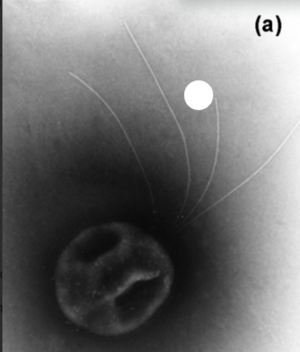Acidilobus saccharovorans: Difference between revisions
| (19 intermediate revisions by 2 users not shown) | |||
| Line 1: | Line 1: | ||
{{Uncurated}} | {{Uncurated}} | ||
[[Image: | [[Image:A. saccharovorans.png|thumb|300px|right|Electron micrographs of <i>A.saccharovorans</i>. Image credit: Microbiology Society.]] | ||
| Line 9: | Line 9: | ||
Thermoproteota; Thermoprotei; Acidilobales; Acidilobaceae | Thermoproteota; Thermoprotei; Acidilobales; Acidilobaceae | ||
| Line 26: | Line 25: | ||
Acidilobus saccharovorans | |||
<i>Acidilobus saccharovorans </i> | |||
==Description and Significance== | ==Description and Significance== | ||
<i>A. saccharovorans<i> has a coccus shape with a bundle of flagella. This archaea also has a thick S-layer. <i>A. saccharovorans<i> was isolated from a terrestrial hot spring. | |||
<i>A. saccharovorans</i> has a coccus shape with a bundle of flagella. This archaea also has a thick S-layer. <i>A. saccharovorans</i> was isolated from a terrestrial hot spring. | |||
==Genome Structure== | ==Genome Structure== | ||
<i>A. saccharovorans<i> consists of a circular genome with 1,496,453 base pairs. <i>A. saccharovorans<i> have no extrachromosomal elements and have one copy of the 16S-23S rRNA operon. There are 246 genes that are unique for <i> A. saccharovorans.<i> | <i>A. saccharovorans</i> consists of a circular genome with 1,496,453 base pairs. <i>A. saccharovorans</i> have no extrachromosomal elements and have one copy of the 16S-23S rRNA operon. There are 246 genes that are unique for <i> A. saccharovorans.</i> | ||
==Cell Structure, Metabolism and Life Cycle== | ==Cell Structure, Metabolism and Life Cycle== | ||
<i>Acidilobus saccharovorans<i> is an anaerobic, organotrophic, thermoacidophilic archaeon. Glucose in <i>A. saccharovorans<i> is metabolized to pyruvate through the Embden-Meyerhof pathway or the Enter-Doudiroff pathway. <i>A. | |||
<i>Acidilobus saccharovorans</i> is an anaerobic, organotrophic, thermoacidophilic archaeon. Glucose in <i>A. saccharovorans</i> is metabolized to pyruvate through the Embden-Meyerhof pathway or the Enter-Doudiroff pathway. <i>A. saccharovorans</i> may conserve energy by doing oxidative phosphorylation. | |||
==Ecology and Pathogenesis== | ==Ecology and Pathogenesis== | ||
<i>A. saccharovorans</i> are found on hot springs. They are believed to help with the complex oxidation of organic material. | |||
<i>A. saccharovorans<i> are found on hot springs. They are believed to help with the complex oxidation of organic material. | |||
==References== | ==References== | ||
[ | [https://www.ncbi.nlm.nih.gov/pmc/articles/PMC2918975/ Mardanov AV, Svetlitchnyi VA, Beletsky AV, Prokofeva MI, Bonch-Osmolovskaya EA, Ravin NV, Skryabin KG. The genome sequence of the crenarchaeon Acidilobus saccharovorans supports a new order, Acidilobales, and suggests an important ecological role in terrestrial acidic hot springs. Appl Environ Microbiol. 2010. 76(16):5652-7. doi: 10.1128/AEM.00599-10.] | ||
[https://www.microbiologyresearch.org/content/journal/ijsem/10.1099/ijs.0.010355-0#tab2 Prokofeva M., Kosyrikina N., Kolganova T., Tourova T., Lysenko A., Lebedinsky A., Bonch-Osmolovskaya E. Isolation of the anaerobic thermoacidophilic crenarchaeote Acidilobus saccharovorans sp. nov. and proposal of Acidilobales ord. nov., including Acidilobaceae fam. nov. and Caldisphaeraceae fam. nov. Biology Society. 2009. 12:3116-22. doi: 10.1099/ijs.0.010355-0.] | |||
==Author== | ==Author== | ||
Latest revision as of 20:50, 6 December 2023
Classification
Thermoproteota; Thermoprotei; Acidilobales; Acidilobaceae
Species
|
NCBI: [1] |
Acidilobus saccharovorans
Description and Significance
A. saccharovorans has a coccus shape with a bundle of flagella. This archaea also has a thick S-layer. A. saccharovorans was isolated from a terrestrial hot spring.
Genome Structure
A. saccharovorans consists of a circular genome with 1,496,453 base pairs. A. saccharovorans have no extrachromosomal elements and have one copy of the 16S-23S rRNA operon. There are 246 genes that are unique for A. saccharovorans.
Cell Structure, Metabolism and Life Cycle
Acidilobus saccharovorans is an anaerobic, organotrophic, thermoacidophilic archaeon. Glucose in A. saccharovorans is metabolized to pyruvate through the Embden-Meyerhof pathway or the Enter-Doudiroff pathway. A. saccharovorans may conserve energy by doing oxidative phosphorylation.
Ecology and Pathogenesis
A. saccharovorans are found on hot springs. They are believed to help with the complex oxidation of organic material.
References
Author
Page authored by Leah Rotte, student of Prof. Bradley Tolar at UNC Wilmington.

